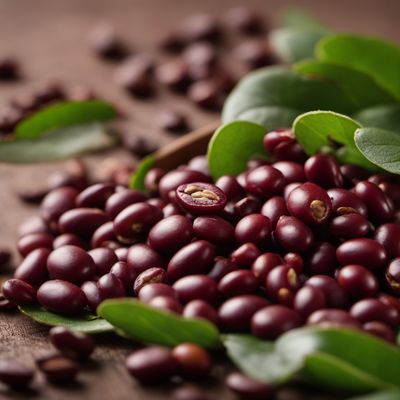
Ingredient
Guar beans (dry)
Versatile Legumes: Guar Beans
Guar beans, also known as cluster beans or cyamopsis tetragonoloba, are small, oval-shaped legumes with a nutty flavor and a slightly crunchy texture when cooked. They are commonly used in Indian cuisine, where they add depth and thickness to gravies, and can also be sprouted or ground into a flour for gluten-free baking. The beans are pale green in color and have a unique appearance with small ridges running along their length.
Origins and history
Guar beans have been cultivated in India for thousands of years and are an integral part of Indian cuisine. They are believed to have originated in the arid regions of Africa and were introduced to India by Arab traders. Guar beans are highly valued for their ability to withstand drought conditions and provide sustenance in challenging environments. Today, they are grown in various countries, including India, Pakistan, Sudan, and the United States.
Nutritional information
Guar beans are a good source of plant-based protein, dietary fiber, and essential minerals such as iron and magnesium. They are also low in fat and calories, making them a nutritious addition to a balanced diet.
Allergens
May cause allergic reactions in individuals with legume allergies.
How to select
When selecting dry guar beans, look for ones that are uniform in size, free from cracks or discoloration, and have a smooth texture. Avoid beans that appear shriveled or damaged, as they may be old or of lower quality. Additionally, opt for organically grown beans to minimize exposure to pesticides and chemicals.
Storage recommendations
To maintain the quality of dry guar beans, store them in a cool, dry place in an airtight container or resealable bag. This will help prevent moisture absorption and keep the beans fresh for an extended period. Avoid exposing them to direct sunlight or high humidity, as this can lead to spoilage or insect infestation.
How to produce
Guar beans can be grown in home gardens by sowing the seeds in well-drained soil and providing adequate sunlight and water. They are relatively easy to cultivate and can be harvested when the pods turn yellow and dry. The beans can then be dried further for storage or used immediately in various recipes.
Preparation tips
Before using dry guar beans, they need to be soaked in water for several hours or overnight to soften them. Once soaked, they can be cooked in boiling water until tender or added directly to soups, stews, curries, or salads. The beans can also be sprouted or ground into a flour for gluten-free baking. Remember to discard the soaking water before cooking to remove any anti-nutritional compounds.
Culinary uses
Guar beans are commonly used in Indian cuisine, where they are added to curries, dals (lentil soups), and vegetable stir-fries. They are also used to thicken gravies and sauces due to their natural gum-like properties. Additionally, guar bean flour can be used as a gluten-free alternative in baking or as a thickening agent in soups and sauces.
Availability
Guar beans are primarily cultivated in India, Pakistan, Sudan, and the United States. They are also grown in smaller quantities in other countries with suitable climates and soil conditions.
More ingredients from this category » Browse all

Borlotti or other common beans (dry)
The Versatile Dried Beans

Yardlong beans (dry)
The Nutrient-Packed Legume: Yardlong Beans

Black eyed peas (dry)
The Lucky Legume

Runner beans (dry)
The Versatile Legume: Exploring the World of Dry Runner Beans

Vetches (dry)
The Nutrient-Packed Legume: Dry Vetches

Broad beans (dry)
Hearty and Nutritious: The Dried Legume Powerhouse

Soyabeans for consumption (dry)
The Versatile Legume

Azuki beans (dry)
The Tiny Powerhouse: Azuki Beans

Monantha vetches (dry)
The Versatile Monantha Vetches

Rice beans (dry)
The Versatile Powerhouse: Rice Beans

Lablab beans (dry)
The Versatile Legume: Lablab Beans

Stink beans (dry)
The Aromatic Delight: Stink Beans